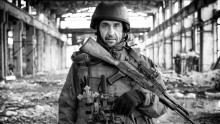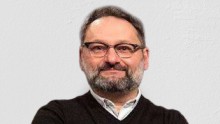“A(r)ma il prossimo tuo” is the name of an exhibit in Turin, Italy, which displays 110 photographs, including 15 taken in Ukraine. Here, the National Museum of the Italian Risorgimento has brought together the destinies of people from different countries and continents. What unites them is one terrible word – war. The authors of the pictures – Paolo Siccardi and Roberto Travan – are well-known Italian photojournalists who usually work in the world’s “hot spots.” Travan, the author of 15 Ukrainian pictures, works for the Italian newspaper La Stampa. It is he who hit upon the idea of organizing this high-profile exposition. Roberto says what unites these pictures is something more than war. Faith, religion, God or what is left of God in a real war – this thin, sometimes invisible, thread goes through the pictures taken at different times in Afghanistan and Israel, Ukraine and Syria, African countries, and the Caucasus. It is difficult to translate the exhibit’s name into English without losing the meaning. In Italian, “Arma il prossimo tuo” (“Arm thy neighbor”) is almost consonant with the biblical “Ama il prossimo tuo” (“Love thy neighbor”).
Travan has visited Ukraine three times during the armed conflict, mostly as a freelance photographer. The journalist is going to visit eastern Ukraine this year, too. The Day spoke to Roberto about the importance of the exhibit’s Ukrainian part, Ukraine in the Italian media space, and the importance of photography as a genre in journalism.
Roberto, you chose a picture taken in Ukraine for the exhibit’s billboard. It looks like all the publications that wrote about the exhibit carried the photo of a Ukrainian soldier. This photo became the exhibit’s “hallmark” of sorts.
“Yes, that’s true. The story of this picture is incredible and dramatic. It shows a Ukrainian soldier, Serhii, whom I met near Donetsk. The photo expresses two essential elements of the exhibit – war and faith. Serhii stood by a ruined industrial facility with a Kalashnikov gun in hand and a cross in the front pocket – I saw it at once. Serhii and I saw each other just for a few seconds because this photo was taken under fire. We ran away in different directions without even getting to know each other better. In a month or so I published this photo in Facebook and, unfortunately, received sad news from a Ukrainian colleague who also worked with me in the Donbas – Serhii had died in action. Naturally, my photographer friends in Ukraine, to whom I also sent the photo, know about our exhibit. It went viral in Facebook and the internet as a whole. A few days ago Serhii’s daughter wrote to me, asking to send her all of her father’s pictures that I have. It is difficult to describe what I felt at the moment. It seemed to me that I’d reopened this girl’s wound. For we, photo reporters, photograph war and see the same war on these pictures, rarely thinking that these people have a private life, interests, and feelings outside the war.

DEBALTSEVE, 2016
“Unfortunately, he is not the only soldier on my photos, who is no longer among us. And it’s not simple. Photographers, journalists ought to take a neutral attitude to these events, but it is impossible to remain indifferent in these conditions.”
You’ve photographed armed conflicts in various countries, on different continents. What do you think singles Ukraine out?
“What impressed me the most is the cohesion of Ukrainians in this war and solidarity of civilians who do not stand clear of the armed conflict and are also fighting – just in other ways. I visited a lot of Donetsk region villages and met many local residents. The conditions they are living in are terrible. But these people chose to stay behind on their native land in spite of everything.
“I was also struck very much with the fact that the whole country helps these frontline residents and the military. The daily work of volunteers, who gather food, clothes, and medicines, is also nothing but another way of fighting in this war.”
This exhibit is of paramount importance. La Stampa is one of the few publications that did and do write about events in Ukraine. Other Italian media cover this topic limitedly and unwillingly.
“Hundreds of people have visited the exhibit in the past two weeks. The exhibit was to last until May, but, owing to great public interest, it was decided to extend it until September. Maybe, we’ll manage to hold it in Rome next year. My observations show that Ukrainian photos form one of the most interesting parts of the exposition for spectators. Of course, the main objective of the exhibit is to make society reflect on war as such and to remind that a lot of armed conflicts are now going on in the world. These conflicts have been dragging on for years and, maybe for this reason, are becoming invisible to peaceful countries. You are right that the Ukraine war is little spoken of. Yes, but little is also being said about the wars in South Sudan, Nagorno-Karabakh, etc. People are just concerned about other problems, and wars seem to be far away.”
Photography is extremely important to The Day as a genre of journalism and a way to put certain ideas across to readers. What can you say about Italian publications?
“I think photography is no less important to Italian publications. It must be a demand of time. The speedy development of the internet has provided an opportunity to inform readers by means of a greater amount of visual information, for the print media are elementarily short of space. Sometimes one picture can say more that a big text. A photo can draw the attention of a much broader audience. There is no language barrier here. So, I think photography as a genre can have a dramatic impact on the information space we have.”









